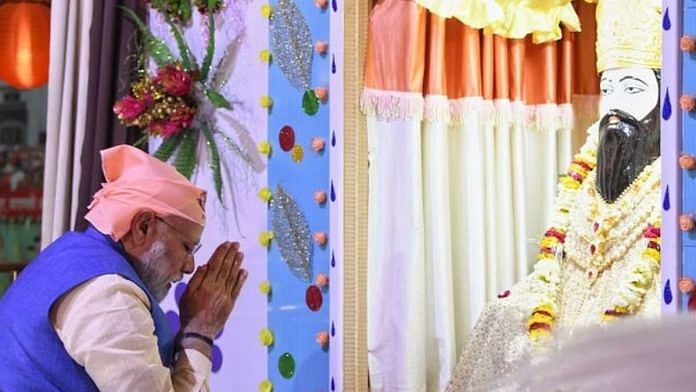From the Himalayas to the Deccan, the shadow of the 2024 Lok Sabha elections is looming across India, with politicians leaving no stone unturned in appealing to voter sentiments through monumental religious edifices. The colossal Rs 1,800 crore Ram Mandir project in Ayodhya, Prime Minister Modi’s anticipated inauguration of the Shri Guru Ravi Das temple in Madhya Pradesh to target scheduled caste votes in the state, and the Rs 1,070 crore Ambedkar Park memorial in Mumbai all underscore calculated play.
In the fervour of political manoeuvring and temple construction, Indian politicians have forgotten the grim reality of the 25,000 bright minds from Scheduled Castes, Scheduled Tribes, and Other Backward Classes who have been compelled to relinquish their dreams of studying at IITs and central universities. The alarming parliamentary data is a stark reminder of the gaping chasm that separates political rhetoric from marginalised students’ lived experiences. Our expenditure does not reflect our priorities.
We continue to invest in our past
While our cultural monuments play a significant role in preserving our heritage and identity, shouldn’t our academic institutions, the nurseries of our future, receive equivalent, if not more, focus? Furthermore, consider the emotional distress of those marginalised students who, despite their potential, are forced to abandon their educational journey due to inadequate resources. Could we not channel a portion of our wealth to uplift these young minds, steering them toward a promising future? We are investing in symbols of our past at the cost of the building blocks of our future.
These questions should invite introspection. Moreover, they demand action, not just answers, for the outcome will determine the course of countless young lives and the trajectory of our nation’s progress. This isn’t simply a fight to reduce dropout rates—it’s a critical battle for preserving dreams and safeguarding our youth’s future. This demands more than mere acknowledgement—it calls for urgent action, a tangible commitment, and a resolute stand against the systemic forces that threaten to thwart young aspirations.
It’s intriguing, and perhaps a touch ironic, that Modi often indulges in light-hearted mockery of studies conducted by Harvard and other international universities to criticise opposition parties. Isn’t it incumbent upon the ruling party to draw inspiration from these global citadels of learning to stop SC/ST/OBC students from dropping out of IITs? Wouldn’t our nation gain immensely if we imbued the best practices of revered institutions such as Harvard and the Massachusetts Institute of Technology (MIT) into our own?
Also read: US ending affirmative action for college admission is alarm for India. Rehaul reservation
Don’t mock Harvard & MIT – learn from them
Transposing Harvard and MIT’s stringent low dropout strategy could be a potent game changer for any educational institution. Harvard’s laudable 99 per cent freshman retention rate is no chance occurrence – it is the result of a meticulous admission procedure complemented by an unwavering focus on holistic student support. A rigorous emulation of these practices could enable universities across the globe to create an environment that galvanises, equips and motivates students to excel in their respective fields. Central to this successful model is the engendering of a sense of belonging, fortified by initiatives such as personalised mentoring, vibrant student-led clubs, and a thriving alum network. Such an atmosphere can foster a resilient academic commitment and promise successful educational outcomes.
MIT, another beacon of academic excellence, is renowned for its driven and ambitious student body—a testament to its highly selective acceptance policies and remarkably low attrition rates. Amid an environment enriched by nurturing faculty and passionate peers, MIT students are empowered to realise their potential, leading to a flurry of commendable accomplishments during their academic sojourn.
Thus, a compelling case emerges for a shift in the educational paradigm—one where institutional policies are aligned not just with rigorous academic pursuits but also with an empathetic understanding of student needs. A nurturing environment that engenders both intellectual curiosity and emotional resilience is crucial. This, perhaps, is the keystone in the arch of a successful academic institution.
If you ever find yourself within the hallowed walls of the Ram Mandir or the sanctum of Guru Ravidas, pause for a moment and ask them this: Do they want temples where prayers echo in their name or an educational institution that nurtures young minds, liberates families, empowers communities, and, perhaps, kindles the spark within the next bearers of their ideologies? Listen closely. Even though the silent edifices may not respond in audible words, the answer will resonate within you; for it lies not in the echoes of the temple halls but in the silent whispers of your own enlightened consciousness.
And when your representative extends their hand to seek your vote, present them with your own question: Will they commit to building a temple of knowledge that nurtures minds and shapes futures, or will they merely pledge another temple honouring a religious figure? Ponder upon their answer and let it guide your decision at the ballot box. Remember, your vote is a powerful testament to your beliefs and aspirations, the torch that can light the path to the India you wish to see—the India of empowered minds, realised dreams, and an enlightened tomorrow.
The author is the president of Foundation for Human Horizon, an UN-affiliated NGO that’s
leading the Anti-Caste legislation movement in the USA and an Artificial Intelligence (AI)
Research Scholar at Johns Hopkins University. Views are personal.
(Edited by Zoya Bhatti)



